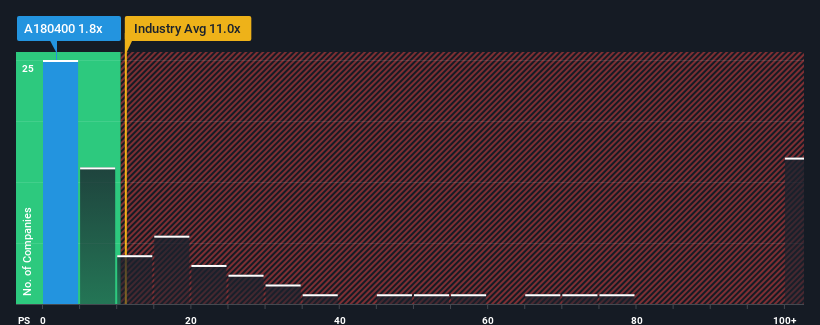- South Korea
- /
- Biotech
- /
- KOSDAQ:A180400
Dx & Vx Co., Ltd. (KOSDAQ:180400) Might Not Be As Mispriced As It Looks After Plunging 37%

The Dx & Vx Co., Ltd. (KOSDAQ:180400) share price has fared very poorly over the last month, falling by a substantial 37%. The recent drop completes a disastrous twelve months for shareholders, who are sitting on a 67% loss during that time.
After such a large drop in price, Dx & Vx's price-to-sales (or "P/S") ratio of 1.8x might make it look like a strong buy right now compared to the wider Biotechs industry in Korea, where around half of the companies have P/S ratios above 11x and even P/S above 36x are quite common. However, the P/S might be quite low for a reason and it requires further investigation to determine if it's justified.
View our latest analysis for Dx & Vx

What Does Dx & Vx's Recent Performance Look Like?
With revenue growth that's exceedingly strong of late, Dx & Vx has been doing very well. It might be that many expect the strong revenue performance to degrade substantially, which has repressed the P/S ratio. Those who are bullish on Dx & Vx will be hoping that this isn't the case, so that they can pick up the stock at a lower valuation.
Although there are no analyst estimates available for Dx & Vx, take a look at this free data-rich visualisation to see how the company stacks up on earnings, revenue and cash flow.Do Revenue Forecasts Match The Low P/S Ratio?
There's an inherent assumption that a company should far underperform the industry for P/S ratios like Dx & Vx's to be considered reasonable.
Retrospectively, the last year delivered an exceptional 37% gain to the company's top line. This great performance means it was also able to deliver immense revenue growth over the last three years. So we can start by confirming that the company has done a tremendous job of growing revenue over that time.
Comparing that to the industry, which is only predicted to deliver 33% growth in the next 12 months, the company's momentum is stronger based on recent medium-term annualised revenue results.
With this in mind, we find it intriguing that Dx & Vx's P/S isn't as high compared to that of its industry peers. It looks like most investors are not convinced the company can maintain its recent growth rates.
What We Can Learn From Dx & Vx's P/S?
Dx & Vx's P/S looks about as weak as its stock price lately. We'd say the price-to-sales ratio's power isn't primarily as a valuation instrument but rather to gauge current investor sentiment and future expectations.
We're very surprised to see Dx & Vx currently trading on a much lower than expected P/S since its recent three-year growth is higher than the wider industry forecast. When we see strong revenue with faster-than-industry growth, we assume there are some significant underlying risks to the company's ability to make money which is applying downwards pressure on the P/S ratio. It appears many are indeed anticipating revenue instability, because the persistence of these recent medium-term conditions would normally provide a boost to the share price.
It is also worth noting that we have found 5 warning signs for Dx & Vx (3 are a bit unpleasant!) that you need to take into consideration.
If these risks are making you reconsider your opinion on Dx & Vx, explore our interactive list of high quality stocks to get an idea of what else is out there.
If you're looking to trade Dx & Vx, open an account with the lowest-cost platform trusted by professionals, Interactive Brokers.
With clients in over 200 countries and territories, and access to 160 markets, IBKR lets you trade stocks, options, futures, forex, bonds and funds from a single integrated account.
Enjoy no hidden fees, no account minimums, and FX conversion rates as low as 0.03%, far better than what most brokers offer.
Sponsored ContentNew: Manage All Your Stock Portfolios in One Place
We've created the ultimate portfolio companion for stock investors, and it's free.
• Connect an unlimited number of Portfolios and see your total in one currency
• Be alerted to new Warning Signs or Risks via email or mobile
• Track the Fair Value of your stocks
Have feedback on this article? Concerned about the content? Get in touch with us directly. Alternatively, email editorial-team (at) simplywallst.com.
This article by Simply Wall St is general in nature. We provide commentary based on historical data and analyst forecasts only using an unbiased methodology and our articles are not intended to be financial advice. It does not constitute a recommendation to buy or sell any stock, and does not take account of your objectives, or your financial situation. We aim to bring you long-term focused analysis driven by fundamental data. Note that our analysis may not factor in the latest price-sensitive company announcements or qualitative material. Simply Wall St has no position in any stocks mentioned.
About KOSDAQ:A180400
Dx & Vx
Engages in the development and sale of bio-health care products and provides molecular genetic testing services primarily in South Korea.
Moderate and slightly overvalued.
Market Insights
Community Narratives



